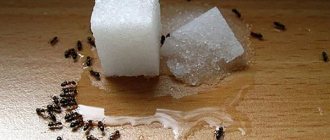Description
Latin name Saduria entomon. Belongs to the class of higher crayfish, order of isopods.
The water cockroach is often called a trilobite. But, if you look at the photo of a sea cockroach, it becomes clear that it looks almost like a land woodlouse. And this coincidence is not accidental. Woodlice also belongs to crustaceans from the order Isopods. These relatives differ in their rear part: the water cockroach has an elongated and pointed tail.
The size of the underwater cockroach is small: no more than 9 cm. In the Baltic Sea, the largest specimens are found at the bottom of the Gulf of Bothnia.
Interesting!
The largest sea cockroaches found by people were 10 cm long.
Although these isopods are not gigantic in size, they are officially recognized as the largest crustaceans of the Baltic Sea. Males are usually larger than females.
The color of isopods can be:
- gray;
- sandy;
- light brown;
- beige.
The color of a sea animal depends on the color of the bottom on which it lives and is of a camouflage nature.
What kind of animal is this sea cockroach, and where does it live?
These are not cockroaches. They are bottom dwellers. Giant "sea cockroaches" live at depths of 170 to 2,200 meters (and possibly deeper) and prefer muddy or clay bottoms in which to hide for cover. They live in the Pacific Ocean, near Japan and in the South China Sea. You can also meet them in the Arctic Ocean and the Baltic Sea. The Gulf of Finland and the Black Sea are also on the list of their habitats. They do not disdain the freshwater lakes of Northern Europe (Ladoga, Vänern, Vättern).
The water cockroach sometimes grows large. Usually they are up to 9 centimeters long. Scientists aren't entirely sure why these sea cockroaches grow so big, but they think their enormous size may be an adaptation that helps them survive the extreme pressures of the deep ocean.
They come in a variety of colors: The sea cockroach's giant shell is made up of overlapping segments and comes in brown, taupe, and lavender.
Body structure
The body shape is a long drop. The aquatic cockroach is covered with a shell, in addition to protection, which serves as an exoskeleton. The body is divided into 8 segments:
- cephalothorax;
- 6 back segments;
- the tail is the longest segment.
The arthropod's paws are attached to the four dorsal segments.
The head of a higher crustacean is protected from the front and sides by pointed plates. Between the plates there are eyes and short whiskers. Below are the gills.
The dorsal segments below also end in pointed plates with spines. Such high-quality protection allowed the animal to live unchanged since the last Ice Age, and perhaps longer.
Lifestyle
The sea cockroach is a predatory animal that feeds on amphipods, small shrimp and mollusks. The basis of the arthropod’s diet is the crustacean Monoporeia affinis.
But very soon the predator may face the problem of hunger. Monoporeia affinis is sensitive to the oxygen content in water. Due to decreased oxygen levels in the Baltic Sea, and especially in the Gulf of Finland, the population of Monoporeia affinis began to decline.
Interesting!
Saduria entomon can also feed on rotting plant remains and carcasses of animals and fish.
How to recognize a sea cockroach?
They have something in common with cats. The water cockroach has widely spaced, fixed compound eyes with over 4,000 individual facets. Cats and crustaceans (and many other animals) have a reflective layer at the back of the eye that reflects light back through the retina and enhances night vision. It is also what makes the eyes of cats and sea cockroaches glow.
They probably don't see very well... It's pretty dark where sea cockroaches live, so vision isn't an important factor for them or for many other deep-sea animals. They use other senses to maneuver, communicate, find food, and find mates.
Most likely they are using their antennas. Sea cockroaches have two sets of antennae which they use to experience the environment around them. Small antennas are used more for chemical sensing, while large antennas are used for physical sensing. When food appears in front of them, they can feel it physically and chemically. They may have a sensory receptor that responds to distortions in the water around them.
The oval flat body is protected by a strong segmented chitinous shell, which gradually tapers and ends in a rather long tail. Gray or gray-brown color allows it to reliably blend into its environment and become unnoticeable to other animals. This can be clearly seen in the underwater photos.
Appearance and structure
Cockroaches are insects; more than 4,000 thousand species live on Earth; the largest number are found in the tropical regions of our planet. About 30 species spend their lives near people and only a few species are the most famous (black, red, American). All of them are united by the fact that according to the scientific classification they belong to the order of cockroaches, and also have a similar body structure. The main structural features of cockroaches:
- A long flat body from 1.5 to 2 cm (in red ones) and up to 10 cm (tropical species), at its end there are two cerci (appendages of the last part of the abdomen), has up to 10 segments depending on the type and sex of the individual cockroach, the ovipositor of the female hidden in the abdomen.
- The head of insects is flat triangular in shape, covered with a scaly shield of the pronotum and has an opistagnothic appearance (the oral cavity is directed downward, closer to the legs).
- The mouth is adapted for gnawing, has strong jaws with chitinous teeth.
- The antennae, which serve as a means of communication between individuals and help to smell food, have an elongated, multi-segmented shape.
- The eyes have a complex structure, are large, include a large number of lenses, covering a large perimeter of vision.
- The elytra cover the hind wings, which fold under them; sometimes there are no wings at all, or there is only one pair of wings.
- The color of chitin varies from brown to black, with the exception of tropical species, which sometimes have bright colors, and there are albinos.
- The main feature is that it has six limbs, armed with spines from below to simplify movement, as well as bristles for sensory perception; they usually have a 5-segmented structure.
What does the beaver eat?
They are predators. Although they are generally thought to be scavengers, feeding on dead animals, some evidence suggests they may also eat slow-moving living organisms such as sponges. Sea cockroaches also attack trawl catches.
Sea cockroaches have four sets of jaws that are adapted for cutting and tearing prey. When they are hungry and there is a lot of food around them, they will continue to eat a lot at one time, and then can go a long time without food. In fact, they eat so much that it compromises their ability to move.
However, they are not aggressive eaters. They definitely won't fight each other for food. Their favorite delicacies: caviar, small fish, other arthropods, remains of the inhabitants of the reservoir and algae.
Since food may be scarce in the deep sea, sea cockroaches limit their energy expenditure. They have a slow metabolism. The mechanics of their bodies are like this because they are deep sea creatures and do not find food all the time. Thus, they may slow down their metabolism and energy levels in order to survive. They don't move that much. Usually they just sit still.
What does a sea cockroach eat?
Stavnitsa is a predator, although many are inclined to think that they are scavengers and they feed on dead “souls”. From other sources it can be assumed that they will not disdain both living organisms and trawl catches.
Water cockroaches have four sets of jaws, thanks to which they easily and quickly deal with prey. If there is a lot of food in front of them, then they will eat everything at once, and then they can exist without food for quite a long time. They may become so full that it is difficult for them to move around after eating.
On the other hand, they cannot be called aggressive. They won't fight for food. They prefer to eat as food: caviar, small fish, other arthropods, algae and others.
Their metabolism is very slow, since it is not so easy to find food at the bottom of the reservoir. So he works very slowly to survive. They are practically motionless, so they have enough food.
How does a sea cockroach reproduce?
Want to tell males from females? Female sea cockroaches have a brood pouch, or marsupial, located on their underside where they hold 20 to 30 eggs. Males have two specialized organs: small white appendages that carry sperm and male appendages that they use to transfer sperm into females. They will insert this organ to transfer sperm anywhere inside the woman after she has moulted - because she becomes soft and can take that sperm.
They have the largest eggs of all marine invertebrates, up to 10 centimeters in diameter. Females do not eat when they are pregnant; instead, they bury themselves in the mud to reduce energy consumption and protect the eggs.
Their babies look like adult sea cockroaches. A nauplius is a larva that has just hatched from an egg. Juvenile sea cockroaches are approximately 5 centimeters long when they emerge. All they're missing is their last pair of legs; when they are fully grown, they will have a total of seven pairs of legs.
To grow, they shed their exoskeletons. Younger sea cockroaches often shed to grow larger, but when they get older, they don't shed as much. They are capable of molting, but they have already reached their size, so because they only need molting to grow.
Features of the life of a sea cockroach
The sea cockroach lives along the coast at a depth of approximately 290 m. Most of its life it lives at the bottom of the reservoir; its favorite types of soil are sand, clay, gravel and mud. The sea cockroach swims quite poorly.
Its diet is varied: this crustacean can feed on plant debris, carrion, and even relatives, but it is also a predator. The sea cockroach preys on small organisms living on the bottom, for example, worm-like arthropods and small mollusks.
Reproduction in sea cockroaches occurs sexually; they are heterosexual creatures. The male fertilizes the female, after which she lays eggs in the ground. When the supply of nutrients is depleted, a larva emerges from the egg, and the first stage of development begins - nauplius.
The body of a sea cockroach larva consists of only two segments. She is quite vulnerable, because her chitinous cover has not yet hardened. As the crustacean grows, new segments form on the side of the tail.
Then comes the next stage of development of the sea cockroach - metanauplius. At this stage, the body of the larva has several segments, and the chitinous cover is already stronger. At this time, molting occurs, as a result of which the shell changes to a new, larger one. At this stage, internal changes of the sea cockroach also occur.
Where does the sea cockroach live?
As already mentioned, the sea cockroach was able to survive the Ice Age; it is not afraid of the cold; it prefers to live in cold waters. Its main habitats are the coastal zone of the Baltic Sea, the Arctic Ocean and the North Pacific Ocean.
This crustacean can also be found in fresh water, in particular in the waters of European lakes: Venern, Vättern and Ladoga.
The sea cockroach is also an invasive species of the Black Sea, first noticed in 2009.
Sea cockroach on the bottom
Are sea cockroaches edible?
If we remember the fact that residents of South America and Southeast Asia have long tried frogs, snakes, grasshoppers and even worms as exotic delicacies, then you shouldn’t be surprised at dishes made from sea cockroaches. Like many crustaceans, they are nutritious and rich in valuable protein. Many gourmets, having tried them for the first time, note their delicate and refined taste, which has a common note with seafood.
In our country, it can be encountered by the average person only in rare cases. For example, sometimes it gets caught in fishermen's nets. There is a certain degree of probability that it can be found in fish products with poor processing. But don’t despair: the sea cockroach is completely safe to eat, only its specific appearance causes negative emotions.
How do waterfowl cockroaches reproduce?
Crustaceans reproduce sexually both in an aquarium and in natural conditions. A larva emerges from the embryo, which has only 2 segments. Each time the chitinous cover comes off, new segments appear.
The transformation of the embryo includes several stages:
- The emerging larva does not have a chitinous cover, so the probability of its death is high.
- The growth zone is concentrated in the anal area. It is activated with every molt.
Each molt is accompanied by a change in size and an increase in meat. In the process, external characteristics also change. The adult looks like a crustacean or shrimp.
Life cycle features
Photos of sea cockroaches predominantly show mature individuals. However, how does the process of reproduction and development of such creatures occur? How is it different from breeding domestic cockroaches?
The process of reproduction occurs through sexual intercourse. Sea cockroaches are heterosexual creatures, with both females and males present. After a female is fertilized, she lays eggs.
Next, a certain cascade of transformations of the embryo occurs, which can be described by the following sequence of events:
- After the supply of nutrients in the egg runs out, the embryo emerges as a nauplius. This is a small larva that has only two segments in its body. Its chitinous cover is still very delicate and does not protect well from mechanical damage.
- Near the anus there is a so-called growth zone, which ensures the further development of the sea cockroach. Metanauplius is its next stage.
Subsequently, the maturing individual must go through a series of molts, during each process changing its internal and external characteristics. As mentioned earlier, sea cockroaches grow as long as their shell allows them to do so. As soon as it reaches the required size, we can talk about a sexually mature individual.
Other marine insects
Shrimp, isopods, even jellyfish earned the title of sea cockroach when they responded to environmental changes by speeding up their reproduction process. Japanese sailors argued that small whales were cockroaches because there were too many of them, which justified the need to hunt them.
Learn More Identification of Marbled Cockroaches
Shrimp, isopods and lobsters all resemble insects crawling along the ocean floor.
How does reproduction occur?
Sea cockroaches reproduce sexually, meaning new organisms are produced from germ cells. When the embryo, feeding on the yolk of the egg, emerges to the surface, it becomes a planktonic larva, which is called a nauplius. Initially, its body consists of two segments, and then new ones are formed in the growth zone located in front of the anal segment.
Scientists call the next stage of development of the larva metanauplius. In general, to achieve full development, the larva needs to undergo several molts, during each of which both external and internal transformations occur.
Is it possible to eat them?
Interesting information for many gourmets will be that the sea cockroach is edible. It tastes a lot like shrimp or crayfish. Its meat is an excellent source of protein and essential microelements.
The only point that may repel potential connoisseurs of exquisite taste is the appearance of such a snack. However, if many peoples of the world eat even ordinary domestic cockroaches, then one should not expect anything bad from their marine “brother”. In any case, everyone decides for themselves what exactly to try again. A sea cockroach treat can be something new and exciting.
Sources
- https://apest.ru/tarakany/2-vidy/60-morskie/
- https://KlopVred.ru/tarakany/morskoj-tarakan/
- https://domvred.ru/morskoj-tarakan/
- https://DomoVreditel.ru/tarakany/morskoj-tarakan
- https://protarakanov.ru/morskie-tarakanyi-opisanie-osobennosti-foto.html
- https://FB.ru/article/243878/morskoy-tarakan-sreda-obitaniya-stroenie-interesnyie-faktyi
[collapse]
Sea cockroach and man
The sea cockroach, although not used in cooking, is theoretically edible, like its close relatives - crayfish and shrimp. The meat of these arthropods is nutritious: rich in protein, micro- and macroelements. But the unattractive appearance of the sea cockroach repels many daring gourmets.
The only harm a sea cockroach can cause to humans is the possibility of it getting into fish products due to poor processing and selection of the catch. Arthropods are often found in fishing nets and cannot always be sorted out. This does not cause any damage to the quality of the product, because the sea cockroach is safe for human consumption, but its appearance brings unpleasant emotions from the purchase.
The sea cockroach is an ancient arthropod that prefers to live in the north. Although it spends its life at the bottom, encounters with humans often occur. The creature does not harm people, and it is useful as part of the biological diversity of water bodies, participating in the food chain.











